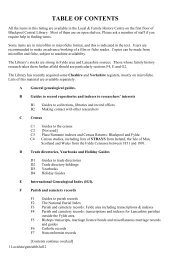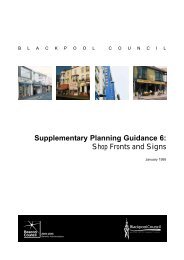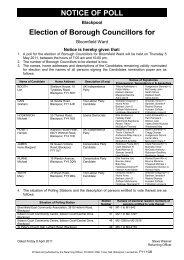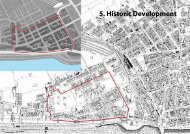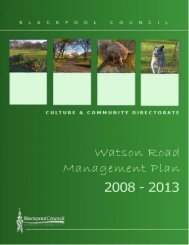Access to and provision of Equipment for people with physical ...
Access to and provision of Equipment for people with physical ...
Access to and provision of Equipment for people with physical ...
Create successful ePaper yourself
Turn your PDF publications into a flip-book with our unique Google optimized e-Paper software.
Blackpool Council - Equality Impact Assessment Record Form from March 2007<br />
Department: Adult Social Care <strong>and</strong> Housing<br />
Team or Service Area Leading Assessment: Policy Team, Strategic Commissioning<br />
Division<br />
Title <strong>of</strong> Policy/ Service or Function: <strong>Access</strong> <strong>to</strong>, <strong>and</strong> Provision <strong>of</strong>, <strong>Equipment</strong> <strong>for</strong> People <strong>with</strong><br />
Physical Disabilities.<br />
Lead Officer: Karen Procter<br />
STEP 1 - IDENTIFYING THE PURPOSE OR AIMS<br />
1. What type <strong>of</strong> policy, service or function is this?<br />
An <strong>Equipment</strong> <strong>provision</strong> function transferred from North Lancashire Primary Care<br />
Trust <strong>to</strong> Blackpool Primary Care Trust (PCT) <strong>and</strong> Blackpool Council Adult Social<br />
Care <strong>and</strong> Housing Department <strong>with</strong> effect from 1 st January 2008<br />
There are proposals <strong>for</strong> further changes <strong>to</strong> the function.<br />
2. What is the aim <strong>and</strong> purpose <strong>of</strong> the policy, service or function?<br />
The new function currently aims <strong>to</strong> improve the efficiency, effectiveness <strong>and</strong> economy <strong>of</strong><br />
the <strong>provision</strong> <strong>of</strong> equipment <strong>to</strong> <strong>people</strong> <strong>with</strong> disabilities.<br />
Additional changes <strong>to</strong> the function are intended <strong>to</strong> be put in place <strong>to</strong> increase personal<br />
choice <strong>and</strong> control <strong>for</strong> users <strong>of</strong> the service.<br />
3. Please outline any proposals being considered.<br />
The <strong>provision</strong> <strong>of</strong> equipment has moved from a Loan S<strong>to</strong>re model managed by North<br />
Lancashire Primary Care Trust <strong>to</strong> a retail model, managed by Blackpool Council Adult<br />
Social Care <strong>and</strong> Housing Department.<br />
It is intended that assessment <strong>for</strong> access <strong>to</strong> basic items <strong>of</strong> equipment (currently via<br />
Occupational Therapy assessment) will be moved from being managed by North<br />
Lancashire Primary Care Trust <strong>to</strong> Blackpool Council Adult Social Care <strong>and</strong> Housing<br />
Department via ‘trusted assessors’.<br />
There will then be three tiers <strong>of</strong> assistance:<br />
1. Factsheet <strong>for</strong> <strong>people</strong> <strong>to</strong> choose <strong>and</strong> purchase themselves (private purchase)<br />
2. Helpdesk advice on purchase if needs more complex - if necessary, referral on <strong>to</strong>:-<br />
3. Occupational Therapy assessment<br />
- 1 -
4. Why are the proposals being made - <strong>for</strong> what reason?<br />
1. The current Loan S<strong>to</strong>re contract was due <strong>for</strong> renewal. The Department <strong>and</strong> Blackpool<br />
PCT wanted a dedicated Blackpool service <strong>for</strong> Blackpool residents<br />
2. There will be increased personal choice through proposals <strong>to</strong> encourage selfhelp/private<br />
purchases.<br />
3. If a ‘trusted assessor’ arrangement is introduced OTs will be freed up <strong>to</strong> focus on more<br />
complex needs assessments <strong>and</strong> there<strong>for</strong>e waiting times <strong>for</strong> such assessments should<br />
reduce.<br />
4. Provision <strong>of</strong> equipment has moved from a Loan S<strong>to</strong>re model <strong>to</strong> a retail model in order<br />
<strong>to</strong> increase; flexibility <strong>of</strong> service, speed <strong>of</strong> delivery, personal control <strong>and</strong> choice. Over<br />
90% <strong>of</strong> equipment supplied previously cost less than £30. In many cases <strong>people</strong> knew<br />
what they wanted <strong>and</strong> needed in<strong>for</strong>mation on where <strong>to</strong> get it, rather than <strong>to</strong> wait much<br />
longer go through an OT assessment <strong>to</strong> get it.<br />
5. All the above should lead <strong>to</strong> reduced overall costs, through better use <strong>of</strong> OT time <strong>and</strong><br />
self purchase <strong>of</strong> smaller items <strong>of</strong> equipment.<br />
5. What outcomes do we want <strong>to</strong> achieve<br />
• increased service user control<br />
• increased service user choice<br />
• More flexible service<br />
• Reduced service costs<br />
• More effective use <strong>of</strong> Occupational Therapists’ time<br />
• Streamlined process<br />
• Improved speed <strong>of</strong> delivery<br />
• Local service focussed on local <strong>people</strong><br />
6. Who is the policy; service or function intended <strong>to</strong> help/ benefit?<br />
People <strong>of</strong> all ages in Blackpool who are assessed as requiring equipment <strong>to</strong>; improve their<br />
ability <strong>to</strong> be as independent as possible, be included in society, undertake the activities <strong>of</strong><br />
daily life, have control <strong>and</strong> choice over their lives.<br />
Carers <strong>of</strong> <strong>people</strong> <strong>with</strong> disabilities as equipment will assist them in their support role.<br />
Blackpool Adult Social Care <strong>and</strong> Housing Department plus Blackpool Primary Care Trust<br />
in terms <strong>of</strong> savings made from providing the equipment service in a more efficient way.<br />
Those savings will be reinvested in<strong>to</strong> Blackpool Adult Social Care services <strong>and</strong> Blackpool<br />
Primary Care Trust respectively.<br />
7. Who are the main stakeholders/ cus<strong>to</strong>mers/ communities <strong>of</strong> interest?<br />
People <strong>of</strong> all ages in Blackpool who require equipment, Blackpool Primary Care Therapy,<br />
Blackpool Adult Social Care <strong>and</strong> Housing Department, carers <strong>of</strong> <strong>people</strong> who require<br />
equipment, Blackpool Vic<strong>to</strong>ria Acute NHS Trust, Occupational Therapy <strong>and</strong> Physiotherapy<br />
staff, Social Care Practitioners, relevant Voluntary <strong>and</strong> Community agencies, retailers <strong>of</strong><br />
- 2 -
equipment.<br />
8. Does the policy, service or function have any existing aims in relation <strong>to</strong> equality,<br />
social inclusion or community cohesion?<br />
• Improved equality <strong>of</strong> access <strong>for</strong> disabled <strong>people</strong> <strong>of</strong> all ages <strong>to</strong>; education,<br />
employment, leisure facilities, public buildings, retail outlets etc through <strong>provision</strong> <strong>of</strong><br />
equipment<br />
• Improved social inclusion through <strong>provision</strong> <strong>of</strong> equipment <strong>to</strong> enable <strong>people</strong> <strong>with</strong><br />
disabilities <strong>to</strong> use community facilities <strong>and</strong> take an active involvement in the<br />
community<br />
9. How is the resulting service or function delivered/ administered?<br />
At present the function covers the delivery <strong>of</strong> equipment:<br />
Stage 1<br />
1. the Occupational Therapist emails an order through <strong>to</strong> one <strong>of</strong> 4 st<strong>and</strong>ard <strong>and</strong>/or 2<br />
specialist suppliers, plus <strong>to</strong> the Helpline Co-ordina<strong>to</strong>r Mailbox.<br />
2. the supplier replies by email <strong>to</strong> both <strong>to</strong> confirm receipt <strong>of</strong> order.<br />
3. the supplier delivers the equipment <strong>to</strong> targets <strong>of</strong>; <strong>with</strong>in 24/48 hours if urgent, or,<br />
48/72 hours if routine<br />
4. the Helpline Co-ordina<strong>to</strong>r rings the cus<strong>to</strong>mer <strong>and</strong> Occupational Therapist <strong>to</strong> check<br />
that the equipment has been delivered <strong>and</strong> that the Occupational Therapist can visit<br />
<strong>to</strong> check.<br />
5. Occupational Therapist visits <strong>to</strong> check installation/use <strong>of</strong> equipment is correct<br />
Stage 2<br />
1. People <strong>with</strong> low level equipment needs will be signposted (via Factsheet) <strong>to</strong><br />
appropriate retail/online providers <strong>of</strong> equipment.<br />
2. A database is <strong>to</strong> be developed <strong>to</strong> assist the helpline opera<strong>to</strong>r in following up orders,<br />
answering queries, plus it will provide necessary Per<strong>for</strong>mance Indica<strong>to</strong>r data re<br />
delivery times.<br />
3. A ‘trusted assessor’ will be used <strong>to</strong> assess <strong>for</strong> ‘simple’ cases where only small items<br />
<strong>of</strong> equipment are likely <strong>to</strong> be required.<br />
STEP 2 - CONSIDERING EXISTING INFORMATION AND WHAT THIS TELLS YOU<br />
10. Please summarise the main data/ research <strong>and</strong> per<strong>for</strong>mance management<br />
in<strong>for</strong>mation in the box below.<br />
Date/ in<strong>for</strong>mation<br />
General Population Data<br />
Blackpool has a resident population <strong>of</strong> some 142,900.<br />
Blackpool has a high percentage <strong>of</strong> residents who are described as separated or divorced<br />
compared <strong>to</strong> the Northwest region <strong>and</strong> Engl<strong>and</strong> & Wales.<br />
- 3 -
Both in numerical <strong>and</strong> percentage terms Blackpool has a small black <strong>and</strong> minority ethnic<br />
(BME) population.<br />
Birth rates <strong>for</strong> Blackpool residents are lower than regional <strong>and</strong> national figures; death rates<br />
are higher. Blackpool had more deaths than it had live births in 2005, whereas the<br />
Northwest Region <strong>and</strong> Engl<strong>and</strong> & Wales had more live births than deaths.<br />
The <strong>of</strong>ficial mid-year estimation process <strong>for</strong> the year 1981-2001 records a reducing<br />
number <strong>of</strong> residents in Blackpool. The most recent estimates from 2003 <strong>to</strong> 2005 suggest<br />
this decline may have halted. Official projections <strong>for</strong> the future indicate a population<br />
increase <strong>to</strong> 159,900 by the year 2029. Official projections <strong>for</strong> the future indicate a rise in 65<br />
plus year olds both in numbers <strong>and</strong> as a proportion <strong>of</strong> the <strong>to</strong>tal population<br />
Research or comparative in<strong>for</strong>mation<br />
Health <strong>and</strong> Disability<br />
A high proportion <strong>of</strong> residents describe their health as “not good” <strong>and</strong> state that they have<br />
a “limiting long term illness”. 42.9% <strong>of</strong> households in Blackpool include one or more person<br />
<strong>with</strong> a limiting long-term illness, statistics in the North West are 38.4% <strong>and</strong> in Engl<strong>and</strong><br />
33.6%.<br />
10% <strong>of</strong> <strong>people</strong> aged between 16-74 are permanently sick or disabled <strong>and</strong> economically<br />
inactive. Percentages are 8% <strong>for</strong> the North West <strong>and</strong> 5% <strong>for</strong> Engl<strong>and</strong>. In Blackpool<br />
approximately a third more men than women are in this category.<br />
115 <strong>people</strong> <strong>of</strong> working age in Blackpool are registered Blind <strong>with</strong> a further 180 registered<br />
as having a sight impairment. 50 <strong>people</strong> <strong>of</strong> working age are registered Deaf <strong>and</strong> a further<br />
135 as having a hearing impairment. 473 <strong>people</strong> <strong>with</strong> dual sensory loss have been<br />
identified.<br />
Life expectancy in Blackpool is a major cause <strong>for</strong> concern; the data suggests that while life<br />
expectancy increased slightly over the ten-year period, progress in extending the<br />
Blackpool life expectancy figures does not compare favourably <strong>with</strong> the national trend <strong>and</strong><br />
other areas. The main causes <strong>of</strong> all deaths in Blackpool are broadly similar <strong>to</strong> those <strong>for</strong><br />
Engl<strong>and</strong> although deaths due <strong>to</strong> the digestive system <strong>and</strong> respira<strong>to</strong>ry system are a little<br />
higher in Blackpool than in Engl<strong>and</strong> as a whole.<br />
The two main causes <strong>for</strong> reduced life expectancy <strong>for</strong> men in Blackpool are digestive<br />
diseases including cirrhosis <strong>of</strong> the liver <strong>and</strong> overdoses <strong>and</strong> poisoning. These are followed<br />
by coronary heart disease, other causes, other circula<strong>to</strong>ry, stroke, self-harm, violence <strong>and</strong><br />
other accidents. The <strong>to</strong>p cause <strong>for</strong> reduced life expectancy <strong>for</strong> women in Blackpool is<br />
digestive diseases including cirrhosis <strong>of</strong> the liver, followed by other respira<strong>to</strong>ry diseases,<br />
lung cancer, other cancer, stroke, coronary heart disease, other circula<strong>to</strong>ry diseases <strong>and</strong><br />
breast cancer.<br />
Deaths from heart disease <strong>and</strong> stroke, smoking <strong>and</strong> cancer are higher in Blackpool than<br />
the regional <strong>and</strong> national average. Estimates suggest there are a higher percentage <strong>of</strong><br />
smokers <strong>and</strong> ex-smokers in Blackpool than in Engl<strong>and</strong> as a whole. Certainly there are<br />
fewer <strong>people</strong> who have never smoked.<br />
Alcohol misuse is a significant problem in the North West. It is estimated that 22% <strong>of</strong><br />
- 4 -
adults in Blackpool binge drink, less than the regional but more than the national average.<br />
Admissions <strong>to</strong> hospital in Blackpool <strong>for</strong> alcohol related conditions are more than the<br />
regional <strong>and</strong> national average<br />
The number <strong>of</strong> drug users aged 15-44 in contact <strong>with</strong> treatment services in Blackpool is<br />
the highest <strong>of</strong> all the local authorities in Engl<strong>and</strong>. There has been a rise in mainstream<br />
misuse <strong>of</strong> steroids in Blackpool.<br />
The number <strong>of</strong> <strong>people</strong> registered <strong>with</strong> severe long-term mental health problems <strong>and</strong> who<br />
are actively accessing treatment is higher than the regional <strong>and</strong> national average<br />
The St<strong>and</strong>ardised mortality ratio <strong>for</strong> all deaths under 75 years in Blackpool are higher than<br />
the average <strong>for</strong> Engl<strong>and</strong>. Male mortality rates in Blackpool exceed female rates <strong>for</strong> key<br />
diseases <strong>for</strong> the under 75’s. Blackpool key disease mortality rates <strong>for</strong> both males <strong>and</strong><br />
females under 75 exceed those <strong>for</strong> Engl<strong>and</strong>.<br />
There has been a decline in Blackpool <strong>for</strong> deaths <strong>of</strong> under 75 year olds <strong>for</strong> both males <strong>and</strong><br />
females in all key diseases except lung cancer where there has been a small increase <strong>for</strong><br />
females.<br />
A ‘low birth weight places a baby at higher risk <strong>of</strong> illness <strong>and</strong> death’. It is demonstrably<br />
linked <strong>to</strong> deprivation. 8.9% <strong>of</strong> babies in Blackpool (all live births) had a low birth weight<br />
(Office <strong>for</strong> National Statistics 2004 data), which is higher than the national figure <strong>of</strong> 7.9%<br />
<strong>for</strong> Engl<strong>and</strong> <strong>and</strong> Wales.<br />
Blackpool Children <strong>with</strong> Physical Disabilities <strong>with</strong> a Planning Record (as at 14/2/08):<br />
Level <strong>of</strong> Need Mild Moderate Severe<br />
Age<br />
4 2 3 + 1 SI*<br />
5 1 1<br />
6 1 2 3 + 1 SI*<br />
7 1 + 1 SI* 2 + 2 SI*<br />
8 2 + 2 SI*<br />
9 1 + 1 SI*<br />
10 4 2<br />
11 1 1 + 2 SI*<br />
12 1 SI* 4 + 2 SI*<br />
13 1 2 1 + 1 SI*<br />
14 3 2 + 1 SI*<br />
15 1 3 + 1 SI*<br />
16 1 1 + 1 SI*<br />
17 6<br />
18 1 SI* 1 + 1 SI*<br />
* SI = Sensory Impairment<br />
General Benefits In<strong>for</strong>mation<br />
More than one third (36.5%) <strong>of</strong> Blackpool’s <strong>to</strong>tal population were claimants <strong>of</strong> at least one<br />
key benefit at August 2006. 23.4% <strong>of</strong> the working age population in Blackpool were<br />
- 5 -
claimants <strong>of</strong> at least one key benefit at August 2006. This was a higher percentage than<br />
<strong>for</strong> the other compara<strong>to</strong>r local authorities <strong>with</strong> the exception <strong>of</strong> Knowsley (28.0%).<br />
13.2% <strong>of</strong> Blackpool’s working population were claimants <strong>of</strong> incapacity benefit at August<br />
2006.<br />
There are seasonal fluctuations in Blackpool <strong>for</strong> Job Seekers Allowance claimants<br />
showing more claimants in the winter months than in the summer months over the past<br />
two years. 2.88% <strong>of</strong> Blackpool’s working age population were Job Seekers Allowance<br />
claimants at August 2006. Knowsley <strong>and</strong> Redcar had a higher percentage <strong>of</strong> their working<br />
age population who were Job Seekers Allowance claimants at August 2006 (4.5% <strong>and</strong><br />
3.9% respectively).<br />
The numbers in Blackpool claiming Job Seekers Allowance are higher in August 2006 than<br />
in the previous two years at the same time <strong>of</strong> year; however, numbers had also increased<br />
in the compara<strong>to</strong>r local authorities.<br />
The numbers claiming income support in Blackpool have decreased between August 2004<br />
<strong>and</strong> August 2006. This is the same <strong>for</strong> the majority <strong>of</strong> the compara<strong>to</strong>r local authorities <strong>with</strong><br />
the exception <strong>of</strong> Bournemouth <strong>and</strong> Poole. Blackpool has a higher number <strong>of</strong> income<br />
support claimants than the other compara<strong>to</strong>r local authorities <strong>with</strong> the exception <strong>of</strong><br />
Knowsley at August 2006.<br />
Just over one fifth (21.7%) <strong>of</strong> Blackpool’s population were claiming a State Retirement<br />
Pension at August 2006. Blackpool has a higher number <strong>of</strong> state retirement pension<br />
claimants than in compara<strong>to</strong>r northern local authorities, <strong>and</strong> a lower number than in the<br />
southern compara<strong>to</strong>r local authorities.<br />
Numbers claiming pension credit in Blackpool have increased between August 2004 <strong>and</strong><br />
August 2006. This is the same <strong>for</strong> the other compara<strong>to</strong>r local authorities.<br />
Blackpool has higher numbers <strong>of</strong> <strong>to</strong>tal benefits claimants than in the other compara<strong>to</strong>r<br />
local authorities <strong>with</strong> the exception <strong>of</strong> Knowsley at August 2006.<br />
Incapacity Benefit & Severe Disability Allowance<br />
Incapacity Benefit is paid <strong>to</strong> <strong>people</strong> who are assessed as being incapable <strong>of</strong> work <strong>and</strong> who<br />
meet certain contribution conditions. Assessment is through the Personal Capability<br />
Assessment (PCA), which measures the claimant’s ability <strong>to</strong> per<strong>for</strong>m a range <strong>of</strong> every-day<br />
activities. Severe Disablement Allowance (SDA) was available until April 2001 <strong>to</strong> those<br />
who did not satisfy the contribution conditions <strong>for</strong> Incapacity Benefit but were incapable <strong>of</strong><br />
work.<br />
The table below shows that numbers claiming Incapacity Benefit <strong>and</strong> Severe Disability<br />
Allowance reduced between August 2004 <strong>and</strong> August 2006 in Blackpool. Numbers <strong>of</strong><br />
cases had reduced between August 2004 <strong>and</strong> August 2006 in all local authorities except<br />
Poole. Numbers <strong>of</strong> cases in Blackpool were higher in 2006 than in the other local<br />
authorities in the table <strong>with</strong> the exception <strong>of</strong> Knowsley.<br />
- 6 -
By February 2007 the <strong>to</strong>tal number <strong>of</strong> claimants had reduced <strong>to</strong> 11,465 (10,520 Incapacity<br />
Benefit <strong>and</strong> 945 Sever Disablement Allowance).<br />
Disability Living Allowance<br />
Disability Living Allowance (DLA) provides a non-contribu<strong>to</strong>ry, non means-tested <strong>and</strong> taxfree<br />
contribution <strong>to</strong>wards the disability-related extra costs <strong>of</strong> severely disabled <strong>people</strong> who<br />
claim help <strong>with</strong> those costs be<strong>for</strong>e the age <strong>of</strong> 65. It has two components which can be paid<br />
<strong>to</strong>gether or on their own; these being, a care component <strong>and</strong> a mobility component. There<br />
were higher numbers <strong>of</strong> <strong>people</strong> eligible as claimants <strong>of</strong> disability living allowance in<br />
Blackpool than <strong>for</strong> the other local authorities in the table <strong>with</strong> the exception <strong>of</strong> Knowsley in<br />
August 2006.<br />
The number <strong>of</strong> claimants had increased in all the local authorities in the table below<br />
between August 2004 <strong>and</strong> August 2006.<br />
Attendance Allowance<br />
Attendance Allowance (AA) provides a non-contribu<strong>to</strong>ry, non-means - tested <strong>and</strong> tax-free<br />
contribution <strong>to</strong>wards the disability-related extra costs <strong>of</strong> severely disabled <strong>people</strong> who are<br />
aged 65 <strong>and</strong> over when they claim help <strong>with</strong> those costs. It can be awarded <strong>for</strong> a fixed or<br />
indefinite period. More <strong>people</strong> in Blackpool were entitled <strong>to</strong> claim attendance allowance<br />
than in the other northern local authorities in August 2006.<br />
- 7 -
Key Benefits <strong>for</strong> all Client Groups <strong>of</strong> all Ages<br />
More than one fifth (21.7%) <strong>of</strong> the population <strong>of</strong> Blackpool are claiming a State pension<br />
(this calculation is based on 2005 mid year estimates). This has remained at a similar level<br />
<strong>for</strong> the past three years. The numbers claiming are higher than in the other Northern local<br />
authorities in the table below but lower than in the Southern coastal local authorities.<br />
The table below shows that 52,110 <strong>people</strong> in Blackpool were in receipt <strong>of</strong> at least one <strong>of</strong><br />
the key benefits from the Department <strong>of</strong> Work <strong>and</strong> Pensions in August 2006. This is<br />
equivalent <strong>to</strong> more than one third <strong>of</strong> the population in Blackpool (36.5%) based on 2005<br />
mid year population estimates. In terms <strong>of</strong> actual numbers there are more <strong>to</strong>tal claimants<br />
in Blackpool than in the other local authorities in the comparative table below <strong>with</strong> the<br />
exception <strong>of</strong> Knowsley.<br />
Race <strong>and</strong> Ethnicity<br />
Blackpool has a very low number/percentage <strong>of</strong> <strong>people</strong> from BME communities <strong>with</strong> 98.4%<br />
classifying themselves as white. The percentages are lower in the North West (94.4%) <strong>and</strong><br />
in Engl<strong>and</strong> (90.9%).<br />
96.59% <strong>of</strong> <strong>people</strong> living in Blackpool were born in the United Kingdom as opposed <strong>to</strong> 95%<br />
regionally <strong>and</strong> 91% nationally. Of those born outside <strong>of</strong> the UK, the highest percentages<br />
were born in Western Europe (0.85%) <strong>and</strong> Asia (0.79%). Those countries outside <strong>of</strong> the<br />
- 8 -
UK where Blackpool residents were born are Germany (586), Italy (191), Pol<strong>and</strong> (127),<br />
South Africa (147), Hong Kong (195), <strong>and</strong> India (218).<br />
There is anecdotal evidence <strong>to</strong> suggest that Blackpool’s Polish community is growing. It is<br />
believed that there are 15,000 Polish <strong>people</strong> in Blackpool <strong>with</strong> 1000 registering <strong>to</strong> work in<br />
the FY postcode area during 2004/2005.There is also evidence that Blackpool has a large<br />
gypsy/traveller population.<br />
The proportion <strong>of</strong> <strong>people</strong> from BME groups who use our services is low compared <strong>to</strong> the<br />
proportion <strong>of</strong> the population from BME groups. There may be a variety <strong>of</strong> cultural reasons<br />
<strong>for</strong> this but the fact remains that there are issues <strong>of</strong> inclusion that may need <strong>to</strong> be<br />
addressed.<br />
Gender <strong>and</strong> Transgender<br />
Blackpool’s population is composed <strong>of</strong> 48% men <strong>and</strong> 52% women (similar <strong>to</strong> national<br />
gender balance).<br />
The Census does not capture in<strong>for</strong>mation on <strong>people</strong> who have changed gender <strong>and</strong> the<br />
Department does not routinely hold such in<strong>for</strong>mation in a <strong>for</strong>mat that would enable data <strong>to</strong><br />
be extracted.<br />
In<strong>for</strong>mation from the University <strong>of</strong> Sal<strong>for</strong>d suggests that there are about 5.000 – 6,000<br />
transgender <strong>people</strong> in the UK who are living permanently in their new gender role.<br />
Religion or belief / faith communities<br />
Only 1.2% <strong>of</strong> the population describe their religion as other than Christian, none/not stated,<br />
<strong>of</strong> which the highest percentage (0.44%) describe themselves as Muslim. The percentages<br />
<strong>of</strong> population <strong>for</strong> the North West are 4.3% (<strong>of</strong> which 3% is Muslim) <strong>and</strong> in Engl<strong>and</strong> the<br />
percentage is 6% (again 3.1% being Muslim <strong>and</strong> 1.1% Hindu).<br />
Sexuality<br />
The percentage <strong>of</strong> <strong>people</strong> indicating they live in a same sex relationship is higher in<br />
Blackpool at 0.5% than in the North West or Engl<strong>and</strong> (0.2%). There is anecdotal evidence<br />
<strong>to</strong> suggest that Blackpool has one <strong>of</strong> the largest gay <strong>and</strong> lesbian populations outside <strong>of</strong> the<br />
country’s largest cities.<br />
Age<br />
Although over half <strong>of</strong> the population (55.1%) are less than 45 years <strong>of</strong> age, Blackpool has<br />
a high proportion <strong>of</strong> older residents, (aged 60 years <strong>and</strong> over), when compared <strong>to</strong> the<br />
Northwest region, <strong>and</strong> Engl<strong>and</strong> & Wales. 23.7% are under 20 years <strong>of</strong> age, 51.2% are<br />
aged between 20 <strong>and</strong> 59; <strong>and</strong> almost one quarter (25.0%) are aged 60 years <strong>and</strong> over.<br />
The retired population will increase. There is an inextricable link between ageing <strong>and</strong><br />
disability <strong>and</strong> almost 61% <strong>of</strong> those <strong>with</strong> a support need are over 60, <strong>and</strong> over 60% <strong>of</strong> them<br />
have a walking difficulty.<br />
- 9 -
Young persons, those aged from 0-17 years, made up 21.1% <strong>of</strong> the whole Blackpool<br />
population at the time <strong>of</strong> the 2001 Census.<br />
Key findings <strong>of</strong> consultation <strong>and</strong> feedback<br />
In 2003/2004 a survey <strong>of</strong> Service Users <strong>with</strong> <strong>physical</strong> disabilities <strong>and</strong> sensory impairments<br />
was carried out. The survey revealed:<br />
• 28% <strong>of</strong> the <strong>people</strong> surveyed felt that their opinions <strong>and</strong> preferences were always taken<br />
in<strong>to</strong> account.<br />
• 26% felt that they did not have as much contact <strong>with</strong> other <strong>people</strong> as they would like.<br />
• 30% felt that Social Services did not provide them <strong>with</strong> the in<strong>for</strong>mation that they<br />
needed.<br />
• 42% said that they had not been <strong>to</strong>ld about direct payments.<br />
• Service Users wanted improvements <strong>to</strong> Home Care <strong>and</strong> access <strong>to</strong> services.<br />
• 37% said that they were not able <strong>to</strong> get out <strong>and</strong> about as <strong>of</strong>ten as they would like.<br />
• 46% said that they spent <strong>to</strong>o long <strong>with</strong> nothing interesting <strong>to</strong> do.<br />
• 53% said that they found it difficult <strong>to</strong> find out about services that may help them.<br />
11. What are the impacts or effects <strong>for</strong> communities?<br />
Race or ethnicity<br />
It is hoped that the <strong>provision</strong> <strong>of</strong> advice over the phone will have a positive impact on takeup<br />
by ethnic communities.<br />
Gender <strong>and</strong> transgender<br />
Positive impact on Blackpool residents <strong>with</strong> a disability.<br />
Impact neutral on equality group.<br />
Age<br />
Positive impact on all Blackpool residents (children, adults <strong>and</strong> older <strong>people</strong>) <strong>with</strong> a<br />
disability.<br />
Disability<br />
Positive impact on all Blackpool residents (children, adults <strong>and</strong> older <strong>people</strong>) <strong>with</strong> a<br />
disability.<br />
Religion or belief/ faith communities<br />
Positive impact on Blackpool residents <strong>with</strong> a disability.<br />
Impact neutral on equality group.<br />
- 10 -
Lesbian, gay, bisexual <strong>people</strong><br />
Positive impact on Blackpool residents <strong>with</strong> a disability.<br />
Impact neutral on equality group.<br />
Other socially excluded communities or groups<br />
Positive impact on Blackpool residents <strong>with</strong> a disability.<br />
No impact on other socially excluded communities or groups.<br />
Relationships between or <strong>with</strong>in communities<br />
Improved integration <strong>of</strong> <strong>people</strong> <strong>with</strong> disabilities in<strong>to</strong> the general community.<br />
12. What do you know about how the proposals will impact on different communities?<br />
Positive impact on all Blackpool residents <strong>of</strong> all ages <strong>with</strong> a disability, <strong>with</strong>in the different<br />
equality groups.<br />
STEP 3 - ASSESSING THE IMPACT<br />
13. Is there any evidence <strong>of</strong> higher or lower take-up by any group or community, <strong>and</strong> if<br />
so, how is this explained?<br />
The ethnicity pr<strong>of</strong>ile <strong>of</strong> Adult Social Care Service Users does not match the local pr<strong>of</strong>ile,<br />
<strong>with</strong> a lower number <strong>of</strong> <strong>people</strong> from minority ethnic backgrounds using services than would<br />
be mathematically predicted. The exact reasons <strong>for</strong> this are not known but there is national<br />
evidence that extended family culture may mean that fewer <strong>people</strong> from minority ethnic<br />
backgrounds access Social Care Services.<br />
14. Does the geography or demography <strong>of</strong> service users reveal anything?<br />
There are higher concentrations <strong>of</strong> <strong>people</strong> <strong>with</strong> long-term disabilities in deprived wards <strong>and</strong><br />
there are wards where the overall population is ageing at a faster rate than others. This<br />
may indicate that there will be a higher dem<strong>and</strong> <strong>for</strong> equipment from these areas.<br />
15. Do any rules or requirements prevent any groups or communities from using or<br />
accessing the service?<br />
<strong>Access</strong> <strong>to</strong> social care services is governed by needs based eligibility criteria, which have<br />
been impact assessed <strong>and</strong> found not <strong>to</strong> cause inequalities.<br />
The new retail model that replaces the ‘Loan S<strong>to</strong>re’ will give <strong>people</strong> the choice, via<br />
signposting, <strong>to</strong> purchase items <strong>of</strong> equipment that they feel will assist them, <strong>with</strong>out having<br />
<strong>to</strong> wait <strong>to</strong> be assessed <strong>for</strong> eligibility <strong>for</strong> such item.<br />
- 11 -
16. Does the way a service is delivered/ or the policy create any additional barriers <strong>for</strong><br />
any groups <strong>of</strong> disabled <strong>people</strong>? (DDA duties arising out <strong>of</strong> DDA 1995)<br />
The equipment service specifically caters <strong>for</strong> <strong>people</strong> (young <strong>and</strong> old) <strong>with</strong> disabilities. The<br />
new way in which the service is now being delivered should further reduce the barriers <strong>to</strong><br />
daily living <strong>for</strong> disabled <strong>people</strong> by being more efficient, effective, flexible <strong>and</strong> responsive.<br />
If there is no access <strong>to</strong> the Helpline via Minicom or mobile phone text this will create a<br />
barrier <strong>for</strong> <strong>people</strong> <strong>with</strong> sensory impairments.<br />
17. Does the way a service is delivered/ or the policy create any additional barriers <strong>for</strong><br />
any other groups or communities, <strong>for</strong> example, due <strong>to</strong> limited income or because <strong>of</strong><br />
the time during the week or day when the service is available? E.g. women, cultural<br />
reasons.<br />
No additional barriers.<br />
18. Do any <strong>of</strong> these limitations amount <strong>to</strong> unlawful discrimination?<br />
Yes No ̌<br />
If yes, please explain (referring <strong>to</strong> relevant legislation) in the box below<br />
19. If No, do they amount <strong>to</strong> a differential impact, which should be addressed?<br />
Yes ̌ No <br />
If yes, please give details in the boxes below.<br />
As the service is designed <strong>for</strong> <strong>people</strong> <strong>with</strong> <strong>physical</strong> disabilities it does not directly impact on<br />
<strong>people</strong> in other equality groups unless they have a disability.<br />
20. If the impact or effects are adverse <strong>for</strong> any community or group, can they be<br />
defended in order <strong>to</strong> provide equality <strong>for</strong> another community under legislation or<br />
policy?<br />
Yes No <br />
Please give details below.<br />
There are no specific adverse impacts.<br />
- 12 -
21. Do you have enough in<strong>for</strong>mation <strong>to</strong> make a judgement?<br />
Yes ̌ No <br />
If no, what in<strong>for</strong>mation do you require, about which communities?<br />
Basic local <strong>and</strong> national in<strong>for</strong>mation about adults <strong>with</strong> disabilities is readily available <strong>and</strong> is<br />
sufficient <strong>to</strong> be able <strong>to</strong> assess the impact <strong>of</strong> the equipment service. However, such<br />
in<strong>for</strong>mation is not as readily available <strong>for</strong> children <strong>with</strong> disabilities, although data on the<br />
numbers <strong>of</strong> children <strong>with</strong> <strong>physical</strong> disabilities <strong>with</strong> a Planning Record have been obtained.<br />
In addition, it may prove helpful <strong>to</strong> obtain more detailed local data <strong>and</strong> in<strong>for</strong>mation <strong>to</strong><br />
broaden knowledge <strong>of</strong> disabled members <strong>of</strong> the other equality target groups.<br />
22. Is it possible <strong>to</strong> get the in<strong>for</strong>mation quickly <strong>and</strong> easily or is it recommended that the<br />
collection <strong>of</strong> such data be included as an action <strong>for</strong> the action plan that will be<br />
developed? Please detail below.<br />
Building up a clearer local picture <strong>of</strong> the disabled community across ALL age groups <strong>and</strong><br />
across other equality groups is likely <strong>to</strong> be resource <strong>and</strong> time intensive. Trends in data will<br />
be as important as baseline data <strong>for</strong> strategic planning purposes. This activity could<br />
perhaps be built in<strong>to</strong> the Department’s Strategic Commissioning function. Central collation<br />
will enable a greater consistency <strong>of</strong> in<strong>for</strong>mation, improved quality <strong>of</strong> in<strong>for</strong>mation, up-<strong>to</strong>-date<br />
in<strong>for</strong>mation, <strong>and</strong> improve strategic decision-making as well as ensuring that the equipment<br />
service can develop in such a way that equality can be assured.<br />
STEP 4 - DEALING WITH ADVERSE OR UNLAWFUL IMPACT<br />
23. What can be done <strong>to</strong> improve the policy, service, function or any proposals in order<br />
<strong>to</strong> reduce or remove any adverse impact or effects identified?<br />
There are no specific adverse impacts - any public in<strong>for</strong>mation produced should carry the<br />
st<strong>and</strong>ard equalities statement <strong>and</strong> consideration should be given <strong>to</strong> minicom <strong>and</strong> text<br />
phone access <strong>to</strong> the equipment team’s helpline.<br />
24. What would be needed <strong>to</strong> be able <strong>to</strong> do this? Are the resources likely <strong>to</strong> be<br />
available?<br />
No resources needed <strong>to</strong> add the equalities statement <strong>to</strong> any public in<strong>for</strong>mation.<br />
Funding would be required <strong>to</strong> add minicom <strong>and</strong> text phone access, although it is not likely<br />
<strong>to</strong> be expensive <strong>and</strong> should be able <strong>to</strong> be funded from <strong>with</strong>in the team’s budget.<br />
25. What other support or changes would be necessary <strong>to</strong> carry out these actions?<br />
AD (Integrated Care Services) <strong>and</strong> PCT managerial approval.<br />
- 13 -
STEP 5 - CONSULTING THOSE AFFECTED FOR THEIR VIEWS<br />
26. Please outline the steps taken <strong>to</strong> test out your findings <strong>and</strong> possible courses <strong>of</strong><br />
action below.<br />
<strong>Equipment</strong> <strong>and</strong> Adaptations Review <strong>for</strong>ms are given <strong>to</strong> all <strong>people</strong> using the equipment<br />
service <strong>to</strong> obtain feedback on the service. The Reviews Team manager may be able <strong>to</strong><br />
provide some analysis <strong>of</strong> recent feedback <strong>for</strong>ms compared <strong>to</strong> the previous <strong>Equipment</strong><br />
service.<br />
27. What feedback or responses have you received <strong>to</strong> the findings <strong>and</strong> possible<br />
courses <strong>of</strong> action? Please give details below.<br />
28. If you have not been able <strong>to</strong> carry out any consultation, please indicate below how<br />
you intend <strong>to</strong> test out your findings <strong>and</strong> recommended actions.<br />
Analysis <strong>of</strong> service user on-line testing <strong>of</strong> websites.<br />
Analysis <strong>of</strong> <strong>Equipment</strong> <strong>and</strong> Adaptations Review <strong>for</strong>ms.<br />
29. If you are impact assessing some proposals, what steps have been taken <strong>to</strong> ensure<br />
that stakeholders have been able <strong>to</strong> voice their opinions on the proposals or the<br />
need <strong>for</strong> change?<br />
The Department <strong>of</strong> Health designed the Retail Model alongside <strong>people</strong> who use <strong>and</strong><br />
deliver services.<br />
In Blackpool, stakeholders have <strong>for</strong>med a Steering Group <strong>to</strong> make decisions on <strong>and</strong><br />
oversee the implementation <strong>of</strong> the proposals.<br />
- 14 -
STEP 6 - ACTION PLANNING<br />
Please outline your proposed action plan below.<br />
Issues/ adverse<br />
impact<br />
identified<br />
<strong>Access</strong><br />
limitations <strong>to</strong><br />
Helpline<br />
Proposed action/<br />
objectives <strong>to</strong> deal<br />
<strong>with</strong> adverse<br />
impact<br />
Purchase <strong>and</strong><br />
incorporate Minicom<br />
<strong>and</strong> text phone<br />
access <strong>to</strong> Helpline<br />
Targets/Measure Timeframe Responsibility Indicate<br />
whether<br />
agreed<br />
Increase the<br />
number <strong>of</strong> <strong>people</strong><br />
accessing advice<br />
through Minicom or<br />
textphone.<br />
April – June<br />
2008<br />
Caroline<br />
Bramhall<br />
√<br />
STEP 7 - ARRANGEMENTS FOR MONITORING AND REVIEW<br />
Please outline your arrangements <strong>for</strong> future moni<strong>to</strong>ring <strong>and</strong> review below.<br />
<strong>Access</strong> <strong>to</strong>, <strong>and</strong> Provision <strong>of</strong>, <strong>Equipment</strong> <strong>for</strong> People <strong>with</strong> Physical Disabilities will be<br />
moni<strong>to</strong>red <strong>and</strong> reviewed annually by the Steering Group<br />
Date completed: 19/02/08<br />
Signed:<br />
Name: Jean Hedley<br />
Position: Assistant Direc<strong>to</strong>r - Central <strong>and</strong> Support<br />
Services<br />
- 15 -



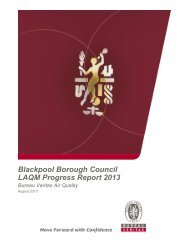
![Control of contractors arrangements [PDF 45KB] - Blackpool ...](https://img.yumpu.com/21999918/1/184x260/control-of-contractors-arrangements-pdf-45kb-blackpool-.jpg?quality=85)
![Day service [PDF 137KB] - Blackpool Borough Council](https://img.yumpu.com/21999915/1/184x260/day-service-pdf-137kb-blackpool-borough-council.jpg?quality=85)
![Mental capacity policy [PDF 126KB] - Blackpool Borough Council](https://img.yumpu.com/21999914/1/184x260/mental-capacity-policy-pdf-126kb-blackpool-borough-council.jpg?quality=85)
